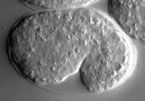
The Caenorhabditis elegans p120 catenin homologue, JAC-1, modulates cadherin–catenin function during epidermal morphogenesis
Jonathan Pettitt1*, Elisabeth A. Cox2*, Ian D. Broadbent1, Aileen Flett1 and Jeff Hardin2
1 Department of Molecular and Cell Biology, University of Aberdeen Institute of Medical Sciences, Aberdeen AB25 2ZD, UK
2 Department of Zoology, University of Wisconsin, Madison, WI 53706
*J. Pettitt and E.A. Cox contributed equally to this work.
Address correspondence to Jonathan Pettitt, Department of Molecular and Cell Biology, University of Aberdeen Institute of Medical Sciences, Aberdeen AB25 2ZD, UK. Tel.: 44-1224-273037. Fax: 44-1224-273144. E-mail: j.pettitt@abdn.ac.uk
Supplemental material for the following paper:
Pettitt, J., Cox, E.A., Broadbent, I.D., Flett, A., and Hardin, J. (2003). The Caenorhabditis elegans p120 catenin homologue, JAC-1, modulates cadherin-catenin function during epidermal morphogenesis. J Cell Biol 162, 15-22.. Medline
Summary
Results
Video sequence 1: Elongation in a wild-type embryo
Video sequence 2: Elongation in a jac-1(RNAi) embryo
Video sequence 3: Elongation in a hmp-1(fe4) embryo
Video sequence 4: Elongation in a hmp-1(fe4);jac-1(RNAi) embryo
Summary
The cadherin–catenin complex is essential for tissue morphogenesis during animal development. In cultured mammalian cells, p120 catenin (p120ctn) is an important regulator of cadherin–catenin complex function. However, information on the role of p120ctn family members in cadherin-dependent events in vivo is limited. We have examined the role of the single Caenorhabditis elegans p120ctn homologue JAC-1 (juxtamembrane domain [JMD]–associated catenin) during epidermal morphogenesis. Similar to other p120ctn family members, JAC-1 binds the JMD of the classical cadherin HMR-1, and GFP-tagged JAC-1 localizes to adherens junctions in an HMR-1–dependent manner. Surprisingly, depleting JAC-1 expression using RNA interference (RNAi) does not result in any obvious defects in embryonic or postembryonic development. However, jac-1(RNAi) does increase the severity and penetrance of morphogenetic defects caused by a hypomorphic mutation in the hmp-1/a-catenin gene. In these hmp-1 mutants, jac-1 depletion causes failure of the embryo to elongate into a worm-like shape, a process that involves contraction of the epidermis. Associated with failed elongation is the detachment of actin bundles from epidermal adherens junctions and failure to maintain cadherin in adherens junctions. These results suggest that JAC-1 acts as a positive modulator of cadherin function in C. elegans.
Return to top
Results
Video sequence 1: Elongation in a wild-type embryo
 |
Wild-type embryo (Nomarski microscopy). Frames were collected every minute for 90-110 min (8 frames/s display rate). |
Click on the link to load video sequence 1: Video sequence #1 (5.8 Mb)
Return to top
Video sequence 2: Elongation in a jac-1(RNAi) embryo
 |
jac-1(RNAi) embryo (Nomarski microscopy). Frames were collected every minute for 90-110 min (8 frames/s display rate). |
Click on the link to load video sequence 2: Video sequence #2 (5.4 Mb)
Return to top
Video sequence 3: Elongation in a hmp-1(fe4) embryo
 |
hmp-1(fe4) embryo (Nomarski microscopy). Frames were collected every minute for 90-110 min (8 frames/s display rate). |
Click on the link to load video sequence 3: Video sequence #3 (4.5 Mb)
Return to top
Video sequence 4: Elongation in a hmp-1(fe4);jac-1(RNAi) embryo
 |
hmp-1(fe4); jac-1(RNAi) embryo (Nomarski microscopy). Frames were collected every minute for 90-110 min (8 frames/s display rate). |
Click on the link to load video sequence 4: Video sequence #4 (7.3 Mb)




